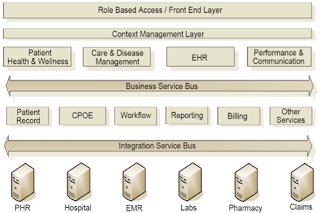
Portals are Web-based applications that give users a centralized point of access for information and applications of relevance. Therefore the portal paradigm is an attractive proposition for health care because it offers a solution to rapidly aggregate heterogeneous applications and services while offering a high level of customization and personalization to the users, patients, care givers and IT personnel.
The integration of healthcare systems and data is a major challenge. Business conditions that typically result in fragmented data stores and limited application functionality are prominent in the healthcare industry.
To meet these challenges, we have created a Portal framework architecture which makes the SOA concept less abstract by offering a concrete service aggregation infrastructure including integration glue like context and code mapping, transformations, master patient index, single sign on and standards based interfaces. The framework facilitates the integration of various applications, so they need not be rewritten to be able to provide services to the portal. Our portal framework is compliant with industry standards such as JSR 168, JSR 286 and WSRP.

In addition to the front-end aggregation layer, a context management layer which uses a subset of the concepts of the HL7 Clinical Context Object Workgroup (CCOW) standard (centralized scheme, robust push-model, simplified context data representation) is used to solve user mapping and facilitate the coordination and synchronization between visual components (portlets in our case). This context management layer connects to the Web services (SOAP or RESTfull) that are exposed by the different systems.
Sessions and Contexts
A portal application like any other web application works with a session. All requests are executed in the context of such session. The session is associated with an authentication context and a lot of other information that is accumulated while processing the requests that are executed with the session. A session can be understood as a temporary storage with a well-defined life cycle. A session is ended either explicitly (log out, connection closing) or by a time-out.
 The basic relationship and mechanism between the sessions, identity and context is described as follow: when accessing the web application for the first time there is no session established yet. The user is forced to log in (providing his identity and the credentials to prove the identity). This establishes an authentication context which is kept within a dedicated session. During the requests executed in a session, information is accumulated and processed in the session.
The basic relationship and mechanism between the sessions, identity and context is described as follow: when accessing the web application for the first time there is no session established yet. The user is forced to log in (providing his identity and the credentials to prove the identity). This establishes an authentication context which is kept within a dedicated session. During the requests executed in a session, information is accumulated and processed in the session. Connecting the Services
Connecting the ServicesBoth the portal application (A) and the remote system (B) may have their own identity management capabilities and their own credential storage. In order to integrate A and B we have implemented an extended SAML based token service. The resulting Security Token Service (STS) service includes the token service module as well as an eHF based context management module. This eHF Context Module stores the mapping information between user identifiers from A and the identities of B.
More complex scenarios
In reality, portal applications typically consist of multiple portlets that interact together. Each portlet can themselves aggregate services from various sources. This is where the portlet proxy is very handy because it can shield the presentation layer from back-end service implementation details.
The integration of a new application exposing web services (SOAP or RESTful) is made easier because eHF provides a mediation and routing platform component (IPF) based on Apache Camel that can wrap these services, operate transformations on data and expose them to the portlet proxies. In addition to this the current use of the Security Token Service for authentication can be complemented by the use of a Single Sign On (SSO) mechanism.
For this specific implementation we used Liferay 5.2. as portal server container and a medicine cabinet as healthcare related topic and material.
More details can be found in the paper "A Portal Framework Architecture for Building Healthcare Web-Based Applications" published at the 3rd International Conference on Health Informatics (Health Inf 2010).

































